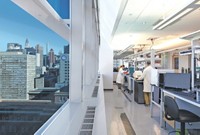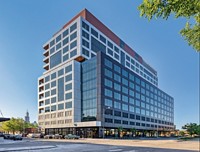Advertisement
Grab your lab coat. Let's get started
Welcome!
Welcome!
Create an account below to get 6 C&EN articles per month, receive newsletters and more - all free.
It seems this is your first time logging in online. Please enter the following information to continue.
As an ACS member you automatically get access to this site. All we need is few more details to create your reading experience.
Not you? Sign in with a different account.
Not you? Sign in with a different account.
ERROR 1
ERROR 1
ERROR 2
ERROR 2
ERROR 2
ERROR 2
ERROR 2
Password and Confirm password must match.
If you have an ACS member number, please enter it here so we can link this account to your membership. (optional)
ERROR 2
ACS values your privacy. By submitting your information, you are gaining access to C&EN and subscribing to our weekly newsletter. We use the information you provide to make your reading experience better, and we will never sell your data to third party members.
Business
Dakota Dream
Sioux Falls and environs have a chance to create a biomedical hub
by Marc S. Reisch
July 8, 2013
| A version of this story appeared in
Volume 91, Issue 27

Daniel Engebretson, a physical chemist, grew up around Sioux Falls, S.D. But when he got his Ph.D. in physical chemistry 15 years ago from Michigan State University, opportunities for chemists were few in his hometown. The closest he could get was across the border in North Dakota, in Fargo, where he worked for a maker of instruments that detect environmental contamination.
Today Engebretson heads the University of South DakotaGraduate Education & Applied Research (GEAR) Center in Sioux Falls, a 22,000-sq-ft facility that links graduate students and private-sector biomedical businesses. “This building was a cornfield four years ago,” says Engebretson, who also chairs USD’s biomedical engineering program.
Adjacent to the GEAR Center is an 80-acre site that will soon become the USD Research Park in Sioux Falls. It’s Engebretson’s field of dreams. He envisions it populated with biotech start-up businesses offering job opportunities to his biomedical engineering graduates. “We don’t want to train kids only to kick them out of the state,” he says.
Engebretson’s effort is just one of several biotech-oriented projects being undertaken by business and academic leaders near Sioux Falls. They see an opportunity to use the area’s two regional health care systems, associated hospitals, and medical school as a foundation for something greater.
Top Sioux Falls Draws
Biomedical research institutions
Avera Research Institute, focusing on complex genetic diseases
Sanford Research, specializing in pediatrics and breast cancer research
Sanford School of Medicine
University of South Dakota Research Park
By the numbers
Health care employment: 20,000
State and corporate income taxes: $0
Distance to Mount Rushmore: 370 miles
Although most people associate South Dakota with corn and other crops, Engebretson and like-minded colleagues think these assets could help make the metropolitan area, with a population of 232,000, a biomedical hub that will bring high-paying jobs and other opportunities for young people.
Wages in South Dakota average about $33,887 a year, notes Ryan Helwig, an economist for the BattelleTechnology Partnership Practice, an economic development consulting group associated with Ohio’s Battelle Memorial Institute. But according to a study Helwig recently helped prepare for the Biotechnology Industry Organization (BIO), a trade group, bioscience jobs in South Dakota pay an average wage of $57,208 a year.
The Sioux Falls area already supports the Sanford School of Medicine, which operates under USD’s aegis in Vermillion, 60 miles to the south. Students train at hospitals operated by the two major Sioux Falls health care systems: Avera and Sanford Health. Avera and Sanford both operate growing biomedical research institutes, and they are avid supporters of entrepreneurial undertakings in the region.
Battelle and BIO’s State Bioscience Industry Development report notes that South Dakota now supports about 5,000 bioscience jobs, including ones in agricultural biotechnology, distribution, and biomedical devices. Given the state’s population of about 833,000 people, “employment in South Dakota biosciences is 5% greater than you would expect to see nationally,” Helwig says.
Yet South Dakota has a way to go to match the likes of biotech powerhouses such as Boston and San Diego. Massachusetts, for instance, supports 78,000 bioscience jobs, 89% greater than population-adjusted national employment averages, according to the Battelle-BIO report.
With its small population a thousand miles or more from East and West Coast biotech centers, South Dakota is often referred to as flyover country, admits Mark Luecke, chief executive officer of South Dakota Innovation Partners, a venture capital firm. “But we’re happy when people fly in, because a lot is going on here,” he says.
As the climate for business start-ups deteriorated in most of the country during the 2008–09 recession, it brightened somewhat in South Dakota, Luecke says. He joined Innovation Partners in 2009, just as state, local, academic, and nonprofit organizations began a push to develop the Sioux Falls region as a biomedical hub, hoping to replace electronics manufacturing jobs that were lost in the recession.
Two years ago, Innovation Partners raised about $6 million from investors, including Avera and Sanford Health, to put into start-up firms. “We’re encouraging large pharmaceutical firms to invest with us, but so far we haven’t succeeded,” Luecke acknowledges. The firm has evaluated 800 deals and funded 10 so far.
Among the companies Innovation Partners has invested in is Tranzderm Solutions, a developer of plant-based transdermal delivery systems for cosmetics and skin disease treatments. Another is Medgene Labs, which is developing therapies, instruments, and assays related to animal diseases, including those that can cross over into humans.
Innovation Partners has also invested in Prairie AquaTech, which has developed a microbe-based process to convert distillers’ grain, a by-product of ethanol production, into high-protein fish food.
All three firms are spin-offs from South Dakota State University in Brookings, 60 miles north of Sioux Falls. SDSU has an active chemistry Ph.D. program and expects to soon launch a biochemistry Ph.D. program. Tranzderm and Medgene operate out of Brookings BioSpace, a new privately owned development that rents lab space at an annual cost of $16 to $18 per sq ft, Luecke says.
By comparison, lab space rents for as much as $70 per sq ft in central Boston, according to a life sciences cluster report from Jones Lang LaSalle, a commercial real estate firm.
Federal stimulus dollars during the economic slowdown also played a role in building the nascent biomedical hub around Sioux Falls. A nearly $7 million grant from the National Institutes of Health helped the Avera Institute for Human Genetics collaborate with Free University of Amsterdam on a registry of 4,985 Dutch twins, their parents, and their siblings.
Such studies help scientists understand the genetic underpinning of disease as they explore why one identical twin may develop diabetes or cancer while the other does not, explains Gareth Davies, scientific director of the institute. Davies, a molecular geneticist, joined Avera in 2007 and now heads a team of 14.
Avera hopes that Davies’ work will advance cost-effective ways to treat disease, says Fred Slunecka, the firm’s chief operating officer. A desire to cut health care costs, Slunecka adds, is also the reason why Avera owns and supports Alúmend, a health care technologies firm that operates out of Engebretson’s GEAR Center in space reserved for start-up firms.
Alúmend is developing a light-activated naphthalimide formulation that is intended to prop open blood vessels in a treatment for peripheral artery disease, says Chief Scientific Officer Ronald Utecht. It is also developing a chitosan-based polysaccharide for tissue bonding and drug delivery. Utecht had a hand in discovering both technologies at SDSU, where he was a professor in the department of chemistry and biochemistry.
Sioux Falls still needs to build up its educational resources, biotech talent, and infrastructure, if a biomedical hub in flyover country is to succeed. One day, perhaps, Alúmend will move into the research park now being planned for Engebretson’s field of dreams. “We want to overlap education and commercial development,” Engebretson says.




Join the conversation
Contact the reporter
Submit a Letter to the Editor for publication
Engage with us on Twitter